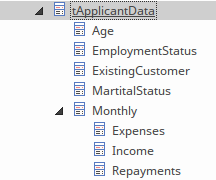| Prev | Next |
Item Definitions and Data Sets
An ItemDefinition describes the types and structures of data items used in a decision model. It serves as the data type definition for InputData elements, Decision elements and Business Knowledge Model parameters. An ItemDefinition can also define Data Sets that provide sets of values for use in DMN Simulations. Switching between different data sets provides the ability to do 'what-if' analysis using the decision model.
ItemDefinition Structure
The tApplicationData ItemDefinition example is a composite type of 5 child items, "Monthly" is composed of 3 children (expenses, Income and repayments). The Leaf components (non composite), will have a primitive type such as number, string or boolean.
A complex ItemDefinition consists of nested Elements. For example the tApplicationData is structured as:

Data Set
The ItemDefinitions Data Set can be viewed and edited using the  icon on the Toolbar. With the data set editing dialog, you can add, delete and duplicate the data sets. There is also support for CSV import and export of data sets.
icon on the Toolbar. With the data set editing dialog, you can add, delete and duplicate the data sets. There is also support for CSV import and export of data sets.
For example, in the bottom-right of the image above, the Item definition for tApplicantData defines 3 data sets:
- Default
- Income4000
- Income5000.
This Data Set can be viewed in an InputData Element that is typed to the ItemDefintion.
For example the "Applicant Data" InputData Element is typed to the ItemDefinition "tApplicantData" and shows the values according to the selection of a data set from the drop-down. See the bottom-left window in the image above.
Setting a Reference to an ItemDefinition
A DMN InputData Element is set to be referenced (typed) by an ItemDefintion using either:
- The
 icon on the DMN Expression window of the InputData Element or
icon on the DMN Expression window of the InputData Element or - Selecting the InputData Element and pressing to select the ItemDefnition from the dialog.
There are other cases of using ItemDefinitions for instance when setting the type for an Input Parameter in a BKM or an output parameter in a Decision Table.